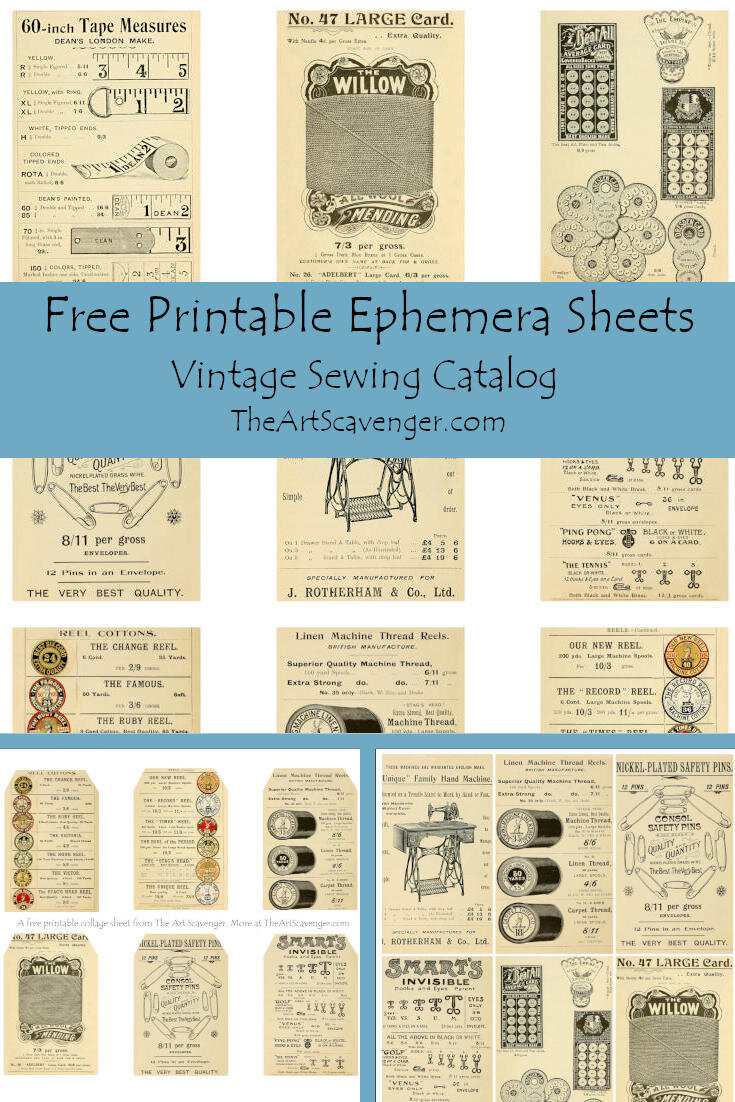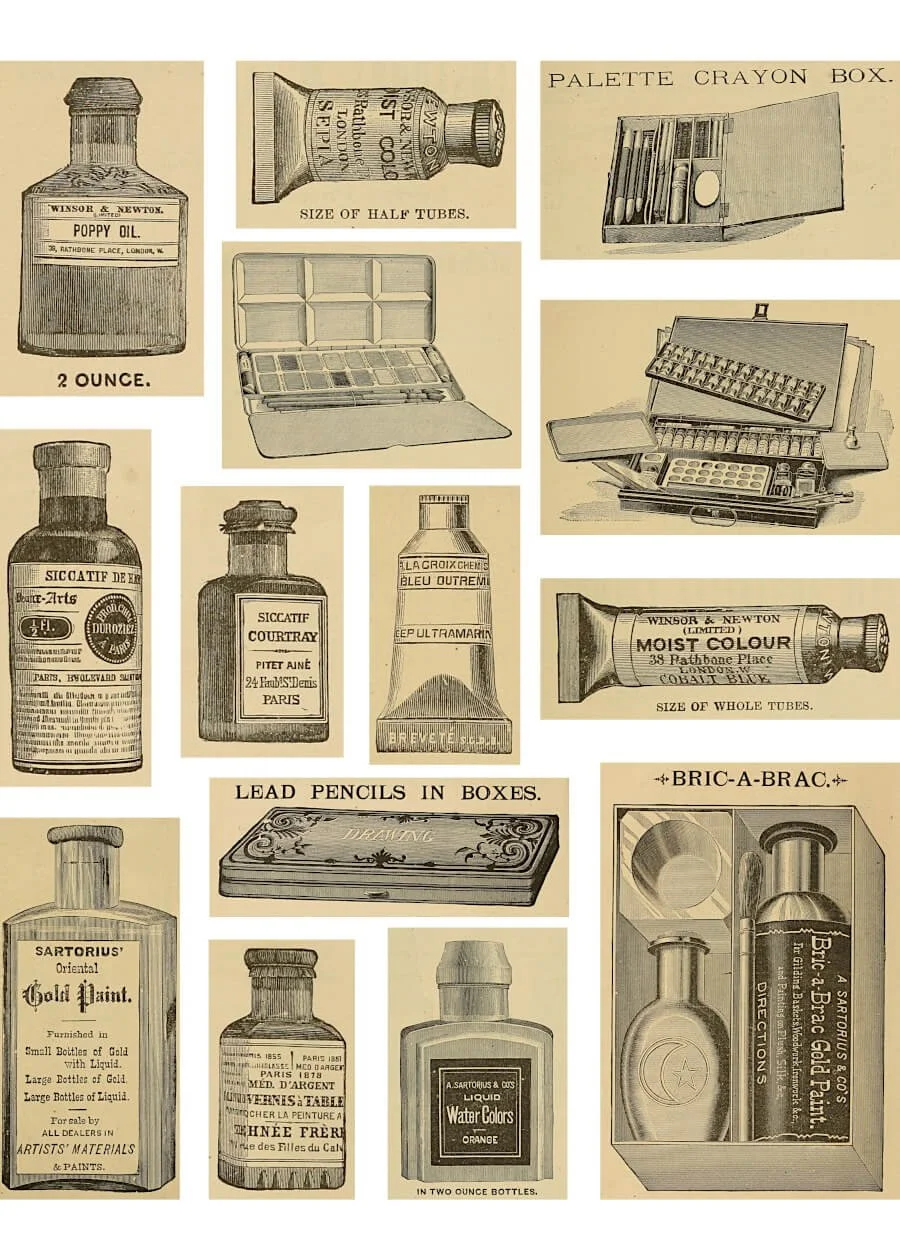Sewing Catalog Ephemera Sheets
Free Printables: Vintage Sewing Catalog Ephemera for Junk Journals & Mixed Media
This collection of free printable collage sheet features vintage illustrations taken from an early 20th-century sewing catalog. Perfect for junk journaling, art journaling, scrapbooking, or mixed media collage, this printable evokes the charm of needlecraft days gone by.
Whether you're a fan of vintage fashion, old-fashioned homemaking, or simply love the textures and typography of antique print materials, this sewing-themed sheet is full of nostalgic character and creative potential.
What’s Included on the Printable
This collage sheet includes a carefully curated selection of sewing-related ephemera from an antique trade catalog. It features:
Illustrations of thread spools and sewing notions
Black and white advertisements for sewing machines and notions
Vintage typography
All images are laid out on high-resolution 8.5 x 11-inch sheets, ready to be printed, trimmed, and layered into your favorite projects. Scroll down and you’ll find a sheet of gift tags, a sheet of 2.5” x 4.25” images, and a sheet of 2” x 3” images.
Please note that the preview images you see one this page are low resolution, but the downloaded sheets are high resolution.
Gift Tags
Creative Uses for This Vintage Sewing Ephemera
There are endless ways to use these sewing-themed graphics in your paper crafts:
Junk Journals & Art Journals
Use them in a themed spread centered on domestic arts, textiles, or creativity. Pair them with fabric scraps, measuring tape ribbon, or stitched paper layers for tactile depth.
Scrapbooking
These images are perfect for heritage pages, especially if you're documenting a family member who loved sewing or tailoring.
Mixed Media Collage
Layer these illustrations with tea-stained paper, lace, or old book pages for a richly textured visual effect. They work beautifully as background or focal elements.
Handmade Tags & Embellishments
Cut out the individual images and turn them into journal cards, altered tags, or tuck spots. These small-format graphics are ideal for layering and clustering.
2.5” x 4.25” Journal Cards
Coordinating Well with Other Themes
The aesthetic of these printables blend seamlessly with:
French labels or handwriting
Neutral, sepia, or blush color palettes
Fabric swatches, lace trims, and buttons
If you enjoy building spreads around specific themes like sewing, millinery, or homemaking, this sheet can serve as a versatile base layer or accent.
Tips for Crafting with the Ephemera
Distress the edges with ink or tearing to add texture
Sew directly onto the paper to incorporate actual stitching
Recolor images with watercolor pencils or tinted gel mediums
These design elements look especially lovely when paired with real sewing notions, like safety pins, bobbins, or bits of fabric, bringing dimension to your journal pages or shadow boxes.
This free printable is part of The Art Scavenger’s ever-growing collection of vintage ephemera for crafters and creators. If you enjoy this one, be sure to explore my full archive of free collage sheets, especially the sewing section, for even more inspiration.
2” x 3” Tags
A Little History About Home Sewing in the Late 19th and Early 20th Century:
Home sewing has a long history, dating back to ancient times when people would make their own clothes using simple tools and techniques. In the Middle Ages, sewing was typically done by hand using a needle and thread, and was considered a necessary skill for both men and women. During the Industrial Revolution in the 18th and 19th centuries, the invention of the sewing machine greatly improved the efficiency and speed of home sewing. This allowed more people to make their own clothes and also led to the rise of the garment industry.
The earliest patent for a sewing machine was issued to Thomas Saint in 1790, but it was not until 1846 that Isaac Singer developed a more practical and functional machine, which he patented and started to produce and sell. By the late 19th century, sewing machines had become a common household item, and they greatly improved the efficiency and speed of home sewing.
In the 19th century, sewing machines were typically powered by a foot pedal and were made of cast iron. They had a straight stitch only and were operated by turning a hand wheel to raise and lower the needle. These early machines were relatively simple, but they were a significant improvement over the previous method of sewing by hand.
Sewing supplies from the 19th century included various types of thread, needles, and fabrics. Threads were made from natural fibers such as cotton or silk, and were often dyed different colors. Needles were made of steel, and were available in various sizes and shapes to suit different fabrics and sewing tasks. Fabrics were also made from natural fibers such as cotton, linen, or wool, and were often hand-woven or produced in small quantities.
In addition, other tools and supplies like thimbles, scissors, and measuring tapes would also have been commonly used in home sewing during the 19th century.
Terms of use:
Free to use for personal or commercial projects. You may print the collage sheets as many times as you wish for your personal crafts or in your projects to sell, including: scrapbooks, junk journals, collage art, etc. You may not redistribute or sell the collage sheets “as is" in either print or digital form.
If you wish to share the files on your own website, please do not make the files available for download directly from your site. Instead, include an image with a link back to this site. Pinning is always welcome and appreciated!
To the best of my knowledge, these are all royalty free images that are in the Public Domain in the US. However, you should always do your own research if you plan to use them commercially.









